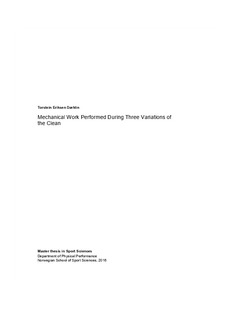Mechanical work performed during three variations of the clean
Master thesis
Permanent lenke
http://hdl.handle.net/11250/2399176Utgivelsesdato
2016-08-15Metadata
Vis full innførselSamlinger
Sammendrag
The purpose of this research was to compare the work performed on the barbell and about the lower extremity joints during the propulsion phase of cleans performed with different objectives. Eight experienced weightlifters (2 females and 6 males) participated in two separate essions. In session one, participants’ one repetition maximum (1 M) clean was determined. Concomitantly, technique was assessed using digital video; all participants demonstrated the towards-away-towards barbell trajectory. In session two, the participants performed cleans with sufficient effort to lift the barbell to 1) the minimum height required to receive it in a full squat (minimal height clean), or with maximum effort to elevate the barbell as high as possible and receiving it in a 2) full (maximal effort clean) or 3) partial (power clean) squat. Work performed on the barbell and about the lower extremity joints were computed from marker trajectories and ground reaction forces. Peak barbell height, total barbell work, total lower extremity net joint work, net knee extensor work, and net knee flexor work were smaller in the minimal height clean than the maximal effort and power cleans (P < 0.05). Moreover, net ankle plantar flexor work was smaller in the minimal height clean than the power clean (P < 0.05). The minimal height clean allowed the same barbell mass to be lifted by performing a smaller work on the barbell and about the lower extremity joints. The smaller net joint work performed during the minimal height clean was primarily accounted for by a smaller net knee extensor and flexor work.
Beskrivelse
Masteroppgave - Norges idrettshøgskole, 2016
